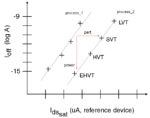The Intel 8086 microprocessor was introduced 42 years ago last month,1 so I made some high-res die photos of the chip to celebrate. The 8086 is one of the most influential chips ever created; it started the x86 architecture that still dominates desktop and server computing today. By looking at the chip’s silicon, we can see… Read More
A Compelling Application for AI in Semiconductor Manufacturing
There have been a multitude of announcements recently relative to the incorporation of machine learning (ML) methods into EDA tool algorithms, mostly in the physical implementation flows. For example, deterministic ML-based decision algorithms applied to cell placement and signal interconnect routing promise to expedite… Read More
Contact over Active Gate Process Requirements for 5G
Summary
A recent process enhancement in advanced nodes is to support the fabrication of contacts directly on the active gate area of a device. At the recent VLSI 2020 Symposium, the critical advantages of this capability were highlighted, specifically in the context of the behavior of RF CMOS devices needed for 5G designs.
Introduction… Read More
A Vibrant Semiconductor Manufacturing Model for the US
Having spent the last 30 years in semiconductor manufacturing, eight years of this living and working in Asia, it is both exciting and unsettling to see renewed political interest in the revitalization of this industry in the United States. Gone are the days of ‘It doesn’t make any difference whether a country makes computer chips… Read More
Optimizing Chiplet-to-Chiplet Communications
Summary
The growing significance of ultra-short reach (USR) interfaces on 2.5D packaging technology has led to a variety of electrical definitions and circuit implementations. TSMC recently presented the approach adopted by their IP development team, for a parallel-bus, clock-forwarded USR interface to optimize power/performance/area… Read More
Intel Designs Chips to Protect from ROP Attacks
Intel comes late to the game but will be delivering an embedded defense for Return Oriented Programming (ROP) types of cyber hacks. I first blogged about this back in Sept of 2016. Yes, almost four years have passed and I had hoped it would see the light of day much earlier.
The feature, to debut in the Tiger Lake microarchitecture… Read More
Multi-Vt Device Offerings for Advanced Process Nodes
Summary
As a result of extensive focus on the development of workfunction metal (WFM) deposition, lithography, and removal, both FinFET and gate-all-around (GAA) devices will offer a wide range of Vt levels for advanced process nodes below 7nm.
Introduction
Cell library and IP designers rely on the availability of nFET and pFET… Read More
Embedded MRAM for High-Performance Applications
Summary
A novel spin-transfer torque magnetoresistive memory (STT-MRAM) IP offering provides an attractive alternative for demanding high-performance embedded applications.
Introduction
There is a strong need for embedded non-volatile memory IP across a wide range of applications, as depicted in the figure below.
The… Read More
Effect of Design on Transistor Density
I have written a lot of articles looking at leading edge processes and comparing the process density. One comment I often get are that the process density numbers I present do not correlate with the actual transistor density on released products. A lot of people want to draw conclusions an Intel’s processes versus TSMC’s processes… Read More
Collaboration Flow for Moore’s Law versus More than Moore
The current Coronavirus crisis is inflicting a lot of pain on people, companies, and governments. I hope I am not getting in trouble with my reasoning, but if you look closely, there are also some “positives” to the Covid-19 crisis.
– It is stress-testing our infrastructure and telling us where we need to improve – as country,… Read More










Website Developers May Have Most to Fear From AI